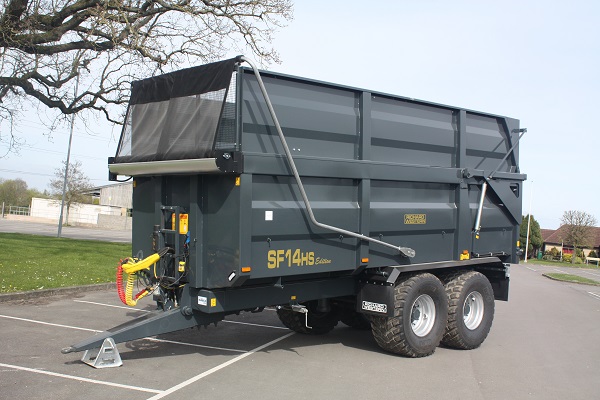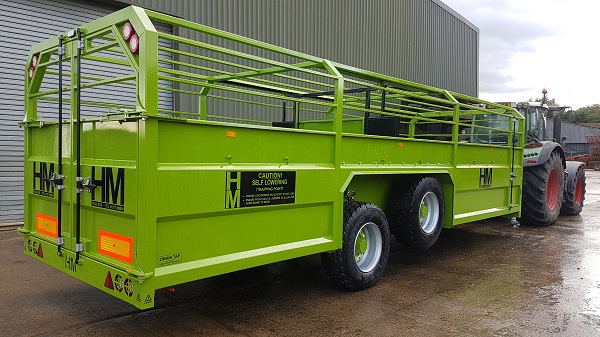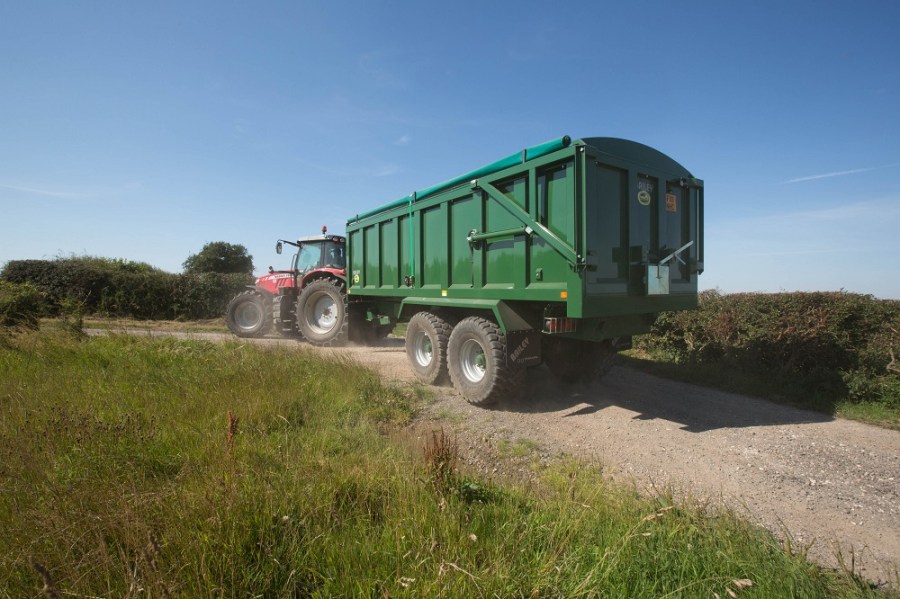Trailer design has moved on as farmers’ requirements have developed. CPM has been asking the bigger manufacturers how their latest models are meeting industry demands.
This is a sector of the machinery market for which customer feedback is a major driver.”
By David Jones
Very few farms in the UK don’t have at least one agricultural trailer. And yet, many farmers, when asked to list their machinery fleet, will not think to include them. This could be seen as being slightly unjust, as trailer technology has been progressing in recent years. This is a sector of the machinery market for which customer feedback is a major driver in its development of new products.
Richard Western
If the industry is demanding something a bit different, then here it is. Western is offering a Special Edition version of some models in its Suffolk range. Designed to appeal to customers looking for something that stands out from the crowd, the Gunmetal Edition should do the trick. Painted gunmetal grey and sporting gold decals, black finish mudguards and various LED lights – yours for an additional £675.
Less eye-catching, but probably of greater significance, will be the appearance this year of two new Suffolk models – the SF15 and SF17. Both will have 6.4m long bodies, and a side height of 1.4m and 1.5m respectively and will be fitted with single five-stage tipping rams.
Two variants – LX and HS – are designed for 50km/h and fast tow tractors and come with LED side markers and hydraulic brakes with a load-sensing valve. A fast tow pack is also available for all models and includes air and hydraulic braking, load-sensing valves, ABS braking, mud guards and flaps.
Western’s sales director, Mike Murray, states that the Suffolk range continues to be the backbone of the business. “We constantly keep the product up to date with the latest innovations in trailer design – a policy which our customers have come to expect. It’s important that we always keep this in mind through every stage of the manufacturing process.”
Standard spec across all models includes hydraulic tailgate with safety hydraulic check valve and rubber tailgate seal, height-adjustable sprung drawbar, commercial mono-leaf spring suspension and shock absorber pads between the trailer body and chassis. In addition, there are twin, three-stage, chrome-tubing tipping rams providing a 55° tipping angle, monocoque body design, front inspection ladder and LED lights.
Mike acknowledges that a key consideration with Western’s customers is to preserve soil structure. “With that fact in mind,” he states, “the majority of our trailers leave the factory fitted with flotation tyres. The popular choice is 560/60R22.5, but we do offer a wide selection of tyre options to satisfy specific customer requirements.”
Suffolk trailers are available in a range of sizes, from 11t to 20t on tandem axles and 20t to 24t on tri-axles with rear wheel steering.

Western’s Gunmetal Special Edition is sure to attract attention.
HM Trailers
If there’s one trailer maker taking the sector into new technical areas, then HM is it. Only in existence since 2000, the Essex company has made a name for itself by adopting and developing further the concept of central tyre inflation on trailers.
As a farming family, the Perrys became frustrated by having trailers that were unable to keep pace with modern combine capacities – and trailers that couldn’t tip in lower buildings. They decided to address these problems themselves and set about developing their own range of grain trailers.
HM director Grant Perry takes up the story. “Looking after the ground is a massive consideration for farmers and landowners alike. It’s the potato and specialist root crop sectors that highlight the need for specialised equipment to protect the land as much as the crop.
“Being farmers ourselves, we put practicality and fitness for purpose first. By prioritising the wellbeing of the land, we have gone down the route of producing an innovative central tyre inflation system that can be activated while on the move – a solution that maximises the performance from flotation tyres and minimises ground compaction.”
There are two options. With the twin line, specialist pipework runs through the axle via a special modification that prevents the pipe from being damaged. The twin line then operates a sealing valve at the rim at the time of a pressure change which, in turn, reduces the chances of the tyres deflating over a period when the trailer is not in use.
A less expensive alternative is the single line, but it requires the presence of ball valves at the rim that need to be closed to reduce the chances of deflation when not in use. The pipework itself, though, remains pressurised.
“Controlled from the cab,” Grant explains, “there’s a choice of digital or analogue operation.” With the digital option, available on the twin-line option, the control box can be cab-based or via an ISOBUS connection. The high/low pressures can be preset or adjusted in 0.1bar increments. The analogue alternative involves the control box being mounted on the trailer and set manually to field and road pressure.
The inflation system can be used on tankers, with tyre pressure calculations needed prior to use and based on the manufacturer’s inflation charts. A pressure of 3.6bar for road work, for example, would deflate to 1.2bar for field use.

HM is claiming its new cattle trailer is the fastest in the world.
Marshalls
The company has been reinventing itself in recent times, a process that sales director Charles Marshall describes as “a massive revision to how we are presenting and displaying our range of products, with a complete re-brand and a new logo.
“There were many reasons for this change, but the result is a fundamental transformation of the business,” he adds. “Everything has been updated, redeveloped and improved, from the quality of the actual product and company, to the visual appearance of each range – as reflected in the new logo.”
With regard to the company’s products, there is an updated dumper trailer design, with the HD/12 model upwards now having a flat floor, with fold-down hydraulic door. This is designed to allow small machines and excavators to be loaded on, so reducing the number of trips customers have to make when moving between sites and making the operation more efficient.
In addition, Charles reports, this year sees the introduction of a new feature for the pushing ram – the VES rear discharge spreader control valve. “This makes it much easier to set the speed of the ram and is a more user-friendly.
McCauleys
The Co. Antrim manufacturer has produced a wide range of trailers for the agricultural sector – and many others – for more than 60 years, under the Mac Trailers brand. From low loaders and general-purpose dump trailers, to flatbeds and turntables.
The company uses 3D computer-aided design to demonstrate to customers seeking specific bespoke features what the final product will look like. The flatbed model pictured has been developed with the task of moving bales and potatoes in mind.
Warwick
According to Warwick’s head of group development, Caroline McCarthy-Stout, the demand for larger, high-capacity trailers has grown progressively over the past few years. In response to this trend, the company has recently launched a new range – the Triple 5 – following feedback from its agricultural agents, who had suggested that the new generation of farmer wanted something more modern.
“The 555 trailer range, which has been designed with root vegetables, sugar beet and cereals in mind, is available in 14t – 20t capacity versions,” Caroline says. “They not only look good, but also incorporate reinforcements within the design, which make it a stronger, more versatile trailer all-round.”
JPM
From its base in Co. Tyrone, Northern Ireland, JPM Trailers builds a wide range of models for the farming and forestry sectors. Many of them in the current range incorporate customers’ ideas from feedback received in the past. The company’s Pat O’Neill describes the main features of one of its best sellers – the 14t dump trailer.
“The standard spec includes eight stud axles, hydraulic brakes, a sprung drawbar, hydraulic door, LED lights and 385/65 R 22.5 wheels,” he says, “while options to suit individual situations include a wheel size upgrade, 10 stud axles, Hardox body finish, hydraulic fold-down door and commercial axles.” The 20t version has commercial axles, air brakes, 445/65 R 22.5 wheels, parabolic suspension and a 12mm floor.
JPM also constructs a multi-purpose version with a hydraulic rear door and 6t aluminium ramps stored under the trailer bed.
Easterby
Constantly seeking to improve, the family-run East Riding company has always been keen to encourage customer feedback and much of the range today incorporates this. Although employing just nine people, the team brings a combined total of 130 years of trailer-building experience and if potential purchasers can’t find a trailer model that suits their specific needs, Easterby’s will design and build one for them.
One of the company’s most popular trailers is the root crop transporter, built to the same basic design as its monocoque grain trailers but longer in the body and with lower sides. This reduces the loading height while raising the tipping height, yet providing the same cubic capacity and minimising damage to the crop.
Easterby’s root crop tippers come in 4.9-7.3m lengths, with carrying capacities of between 8t and 16t.
Bailey
The Lincs manufacturer has expanded its production of trailers in recent years, moving to a new purpose-built factory at Sleaford and subsequently adding a fitting and finishing facility.
Bailey has recently introduced a new sugar beet trailer model. The Beeteaper’s most noticeable feature is that it tips to an angle of 60°, while the hydraulic rear door has longer side arms and hydraulic rams that allow the rear door to open higher. This has the effect of allowing the beet to be heaped to approximately 2.7m. The company describes this model as multi-purpose, as it can also be used with grain and other crops.




